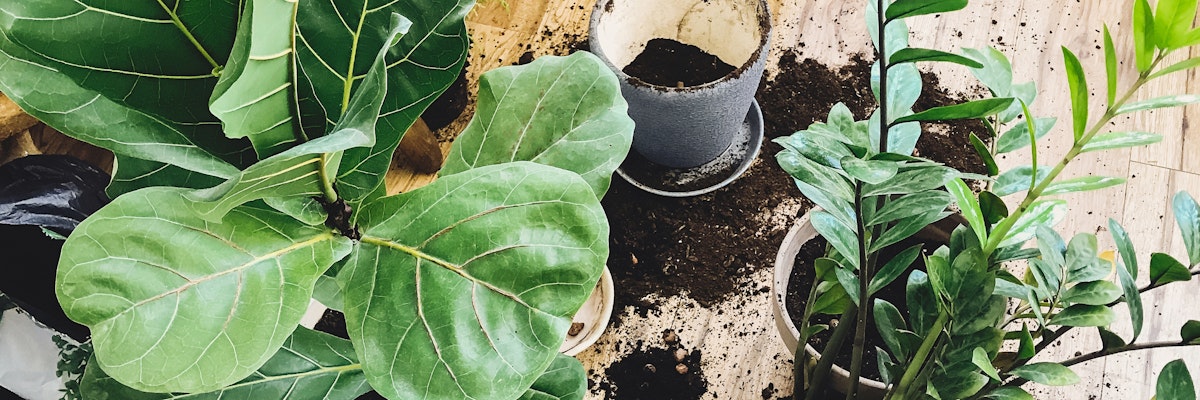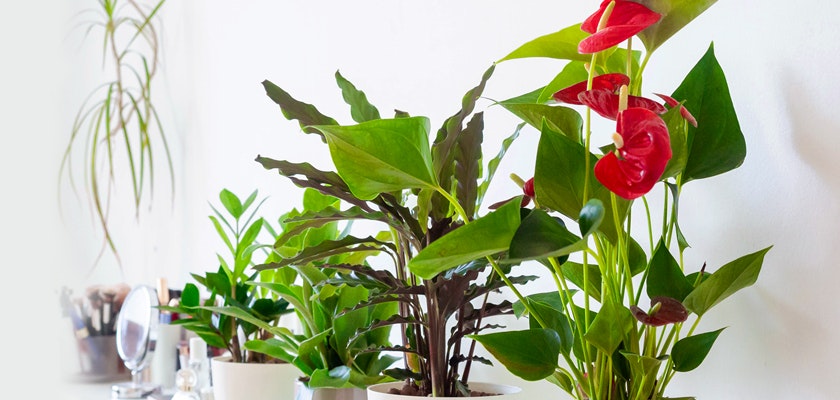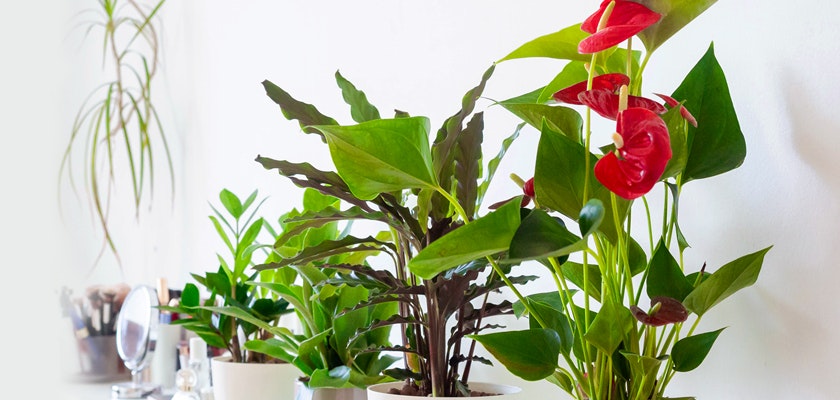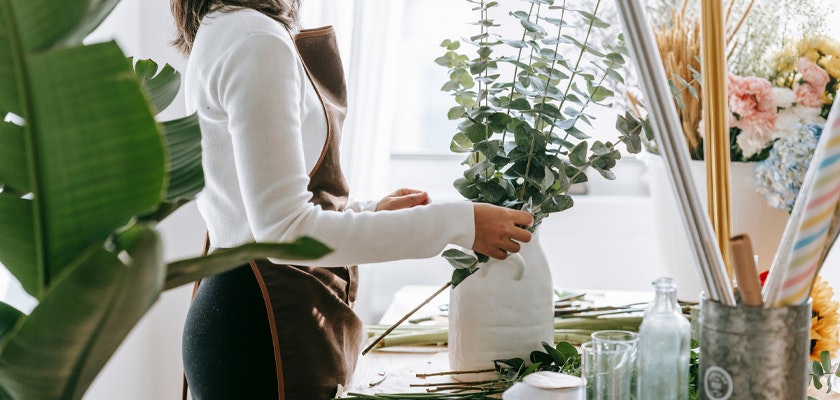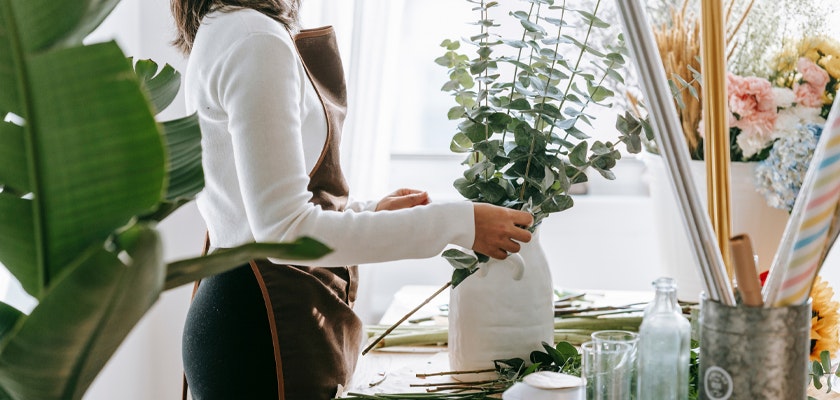BloomsyBox's Ultimate Guide to Homemade Plant Food
Welcome to BloomsyBox’s in-depth exploration into the world of homemade plant food, a key ingredient in nurturing a vibrant and thriving indoor garden.
Discover BloomsyBox's DIY nutrient solutions for lush plants
At BloomsyBox, we understand that the health of your plants is paramount, and finding the right nutrition can be a game-changer. This guide is meticulously crafted to walk you through the simple yet effective ways to feed your house plants delivered using ingredients you likely already have at home. Whether you're a seasoned gardener or a novice looking to greenify your space, our guide promises to equip you with all you need to know about homemade plant nourishment.
Discover BloomsyBox's DIY nutrient solutions for lush plants
At BloomsyBox, we understand that the health of your plants is paramount, and finding the right nutrition can be a game-changer. This guide is meticulously crafted to walk you through the simple yet effective ways to feed your house plants delivered using ingredients you likely already have at home. Whether you're a seasoned gardener or a novice looking to greenify your space, our guide promises to equip you with all you need to know about homemade plant nourishment.
1. Simple Sugar Solution
Plants can benefit from the occasional sweet treat, just like us. Dissolve one teaspoon of sugar in 2 liters of water and use it to water your plants. This solution acts as a quick source of energy for your plants, encouraging growth. Be mindful; too much sugar can harm your plants, so use this sparingly, ideally once a month, as a little pick-me-up during the growing season.
Sugar is not just for sweetening your tea; it’s also a source of carbohydrates for plants, aiding in their energy processes. This straightforward recipe is especially beneficial during the peak growing months when plants are actively producing foliage and flowers. It's a simple yet effective way to give your plants a gentle boost without resorting to complex chemical fertilizers.
2. Eggshell Tea
Eggshells are rich in calcium, a critical element for cell wall structure and plant strength. Rinse and collect eggshells, then boil them in a gallon of water for about 5 minutes. Allow the mixture to steep overnight, strain, and use the liquid to water your plants. This process extracts soluble calcium from the shells, offering your plants a vital nutrient that promotes healthy cellular development and growth.
Using eggshell tea is particularly advantageous for plants prone to calcium deficiencies, such as tomatoes and peppers, which can suffer from blossom end rot without adequate calcium. This homemade solution is a sustainable way to recycle kitchen waste while providing your plants with essential nutrients, demonstrating that effective gardening solutions can be both simple and eco-friendly.
3. Banana Peel Brew
Bananas are well-known for their potassium content, which is crucial for plant health, aiding in water regulation, enzyme activation, and photosynthesis. Chop up banana peels, then soak them in a jar of water for about a week. Afterward, use this nutrient-rich water to hydrate your plants. The fermentation process helps release potassium, making it readily available for plant uptake.
This brew not only delivers potassium but also small amounts of phosphorus and magnesium, supporting root development and overall plant vigor. It's a wonderful example of how everyday food scraps can be transformed into valuable plant nourishment, aligning perfectly with BloomsyBox’s ethos of sustainability and resourcefulness in gardening.
4. Coffee Ground Fertilizer
Coffee grounds are a fantastic source of nitrogen, encouraging lush leaf growth. Simply sprinkle used coffee grounds around the soil or mix them with water to create a liquid fertilizer. For the liquid version, add half a pound of wet coffee grounds to 5 gallons of water and let it sit for 24 hours before applying it to the soil.
The acidity in the coffee grounds can also help to lower the pH level of the soil, benefiting acid-loving plants such as azaleas and blueberries. Incorporating coffee grounds into your gardening routine is an excellent way to repurpose waste while enriching your soil with organic matter, promoting healthy, vibrant plant growth.
5. Seaweed Solution
Seaweed is packed with trace minerals and nutrients that can stimulate plant growth and increase resistance to diseases and pests. If you have access to fresh seaweed, rinse it thoroughly to remove salt, chop it up, and allow it to ferment in a bucket of water for a couple of weeks. Strain the liquid and use it to water your plants or spray directly onto the foliage.
The benefits of seaweed extend beyond basic nutrition; it also contains natural growth hormones and cytokinins that encourage cell division and growth. This seaweed solution is a testament to the power of natural resources in supporting plant health, offering a comprehensive range of nutrients in a form that's easily absorbed by plants.
1. Simple Sugar Solution
Plants can benefit from the occasional sweet treat, just like us. Dissolve one teaspoon of sugar in 2 liters of water and use it to water your plants. This solution acts as a quick source of energy for your plants, encouraging growth. Be mindful; too much sugar can harm your plants, so use this sparingly, ideally once a month, as a little pick-me-up during the growing season.
Sugar is not just for sweetening your tea; it’s also a source of carbohydrates for plants, aiding in their energy processes. This straightforward recipe is especially beneficial during the peak growing months when plants are actively producing foliage and flowers. It's a simple yet effective way to give your plants a gentle boost without resorting to complex chemical fertilizers.
2. Eggshell Tea
Eggshells are rich in calcium, a critical element for cell wall structure and plant strength. Rinse and collect eggshells, then boil them in a gallon of water for about 5 minutes. Allow the mixture to steep overnight, strain, and use the liquid to water your plants. This process extracts soluble calcium from the shells, offering your plants a vital nutrient that promotes healthy cellular development and growth.
Using eggshell tea is particularly advantageous for plants prone to calcium deficiencies, such as tomatoes and peppers, which can suffer from blossom end rot without adequate calcium. This homemade solution is a sustainable way to recycle kitchen waste while providing your plants with essential nutrients, demonstrating that effective gardening solutions can be both simple and eco-friendly.
3. Banana Peel Brew
Bananas are well-known for their potassium content, which is crucial for plant health, aiding in water regulation, enzyme activation, and photosynthesis. Chop up banana peels, then soak them in a jar of water for about a week. Afterward, use this nutrient-rich water to hydrate your plants. The fermentation process helps release potassium, making it readily available for plant uptake.
This brew not only delivers potassium but also small amounts of phosphorus and magnesium, supporting root development and overall plant vigor. It's a wonderful example of how everyday food scraps can be transformed into valuable plant nourishment, aligning perfectly with BloomsyBox’s ethos of sustainability and resourcefulness in gardening.
4. Coffee Ground Fertilizer
Coffee grounds are a fantastic source of nitrogen, encouraging lush leaf growth. Simply sprinkle used coffee grounds around the soil or mix them with water to create a liquid fertilizer. For the liquid version, add half a pound of wet coffee grounds to 5 gallons of water and let it sit for 24 hours before applying it to the soil.
The acidity in the coffee grounds can also help to lower the pH level of the soil, benefiting acid-loving plants such as azaleas and blueberries. Incorporating coffee grounds into your gardening routine is an excellent way to repurpose waste while enriching your soil with organic matter, promoting healthy, vibrant plant growth.
5. Seaweed Solution
Seaweed is packed with trace minerals and nutrients that can stimulate plant growth and increase resistance to diseases and pests. If you have access to fresh seaweed, rinse it thoroughly to remove salt, chop it up, and allow it to ferment in a bucket of water for a couple of weeks. Strain the liquid and use it to water your plants or spray directly onto the foliage.
The benefits of seaweed extend beyond basic nutrition; it also contains natural growth hormones and cytokinins that encourage cell division and growth. This seaweed solution is a testament to the power of natural resources in supporting plant health, offering a comprehensive range of nutrients in a form that's easily absorbed by plants.
6. Wood Ash Tea
Wood ash from your fireplace can be an excellent source of potassium and calcium carbonate, acting as a liming agent to reduce soil acidity. To make wood ash tea, simply place wood ash in a cloth bag and steep it in a bucket of water for a few days. Use this solution to water your plants, helping to improve soil pH balance and provide essential nutrients.
It's important to use wood ash sparingly and to test your soil's pH before application, as too much can lead to alkaline conditions unfavorable for many plants. This recipe highlights the innovative ways gardeners can repurpose natural by-products into valuable gardening aids, aligning with BloomsyBox’s commitment to eco-conscious living.
7. Compost Tea
Compost tea is a versatile and nutrient-rich solution made by steeping compost in water. Fill a burlap sack with compost and submerge it in a barrel of water. Allow it to steep for a week, stirring occasionally. The resulting tea is a concentrated liquid fertilizer that can be diluted and used to water your plants or as a foliar spray.
This method extracts beneficial microorganisms and nutrients from the compost, creating a dynamic, living fertilizer that enhances soil health and plant resilience. Compost tea exemplifies the principles of regenerative gardening, turning waste into wealth in an effort to nurture both plants and the planet.
8. Vinegar Solution
A mild vinegar solution can help increase the acidity of your soil, benefiting acid-loving plants. Mix one tablespoon of white vinegar with a gallon of water and use it to water your plants. This should be done sparingly, as too much acidity can harm your plants. It’s ideal for plants like hydrangeas, rhododendrons, and gardenias that thrive in acidic environments.
Vinegar is more than just a kitchen staple; it’s a versatile gardening tool that, when used correctly, can modify soil conditions to favor the growth of specific plants. This recipe underscores the importance of understanding your plants’ pH preferences and demonstrates how household items can be repurposed to support garden health.
9. Green Tea Tonic
Green tea is not only beneficial for humans but also for plants. A weak green tea solution can provide plants with antioxidants, vitamins, and minerals. Brew a weak tea (one used tea bag per 2 gallons of water) and use it to water plants every four weeks. This gentle tonic supports overall plant health, aiding in the development of strong, disease-resistant foliage.
The use of green tea as a plant tonic is a creative way to apply the nutritional benefits of tea to the garden, embodying BloomsyBox’s innovative approach to plant care. It’s a reminder that many of the healthful substances we consume can also enrich our plants, closing the loop in a cycle of nourishment and growth.
10. Molasses Mix
Molasses provides a quick source of energy for soil microbes, enhancing soil fertility and plant growth. Mix one tablespoon of unsulphured molasses with a gallon of water and use it to water your plants. This solution is particularly beneficial during the vegetative growth phase, stimulating microbial activity in the soil and improving nutrient availability.
Molasses is a powerhouse of sugars and minerals for plants, acting as a catalyst for healthy soil biology. This recipe is a nod to the symbiotic relationship between plants and soil life, highlighting the role of soil health in producing thriving, vigorous plants.
6. Wood Ash Tea
Wood ash from your fireplace can be an excellent source of potassium and calcium carbonate, acting as a liming agent to reduce soil acidity. To make wood ash tea, simply place wood ash in a cloth bag and steep it in a bucket of water for a few days. Use this solution to water your plants, helping to improve soil pH balance and provide essential nutrients.
It's important to use wood ash sparingly and to test your soil's pH before application, as too much can lead to alkaline conditions unfavorable for many plants. This recipe highlights the innovative ways gardeners can repurpose natural by-products into valuable gardening aids, aligning with BloomsyBox’s commitment to eco-conscious living.
7. Compost Tea
Compost tea is a versatile and nutrient-rich solution made by steeping compost in water. Fill a burlap sack with compost and submerge it in a barrel of water. Allow it to steep for a week, stirring occasionally. The resulting tea is a concentrated liquid fertilizer that can be diluted and used to water your plants or as a foliar spray.
This method extracts beneficial microorganisms and nutrients from the compost, creating a dynamic, living fertilizer that enhances soil health and plant resilience. Compost tea exemplifies the principles of regenerative gardening, turning waste into wealth in an effort to nurture both plants and the planet.
8. Vinegar Solution
A mild vinegar solution can help increase the acidity of your soil, benefiting acid-loving plants. Mix one tablespoon of white vinegar with a gallon of water and use it to water your plants. This should be done sparingly, as too much acidity can harm your plants. It’s ideal for plants like hydrangeas, rhododendrons, and gardenias that thrive in acidic environments.
Vinegar is more than just a kitchen staple; it’s a versatile gardening tool that, when used correctly, can modify soil conditions to favor the growth of specific plants. This recipe underscores the importance of understanding your plants’ pH preferences and demonstrates how household items can be repurposed to support garden health.
9. Green Tea Tonic
Green tea is not only beneficial for humans but also for plants. A weak green tea solution can provide plants with antioxidants, vitamins, and minerals. Brew a weak tea (one used tea bag per 2 gallons of water) and use it to water plants every four weeks. This gentle tonic supports overall plant health, aiding in the development of strong, disease-resistant foliage.
The use of green tea as a plant tonic is a creative way to apply the nutritional benefits of tea to the garden, embodying BloomsyBox’s innovative approach to plant care. It’s a reminder that many of the healthful substances we consume can also enrich our plants, closing the loop in a cycle of nourishment and growth.
10. Molasses Mix
Molasses provides a quick source of energy for soil microbes, enhancing soil fertility and plant growth. Mix one tablespoon of unsulphured molasses with a gallon of water and use it to water your plants. This solution is particularly beneficial during the vegetative growth phase, stimulating microbial activity in the soil and improving nutrient availability.
Molasses is a powerhouse of sugars and minerals for plants, acting as a catalyst for healthy soil biology. This recipe is a nod to the symbiotic relationship between plants and soil life, highlighting the role of soil health in producing thriving, vigorous plants.
In the quest for a thriving indoor garden, the role of bespoke nutrient solutions cannot be overstated. BloomsyBox's exploration into DIY plant food recipes offers a gateway to understanding and meeting the diverse nutritional needs of your plants. These homemade concoctions, apart from being cost-effective and environmentally friendly, invite gardeners to engage more deeply with their green companions. By preparing these nutrient-rich solutions, you not only provide your plants with the essential building blocks for growth but also foster a sustainable gardening practice that benefits both your home environment and the planet.
The process of selecting, mixing, and applying these nutrient solutions represents a form of caretaking that is both science and art. It encourages a mindful approach to gardening, where observation and responsiveness lead to lush foliage, vibrant blooms, and healthy growth. This guide, rooted in BloomsyBox’s commitment to eco-conscious and responsible gardening, is designed to empower plant enthusiasts at every level. Whether you're a seasoned gardener or new to the world of indoor plants, the recipes outlined serve as a foundation for nurturing your green spaces with intention and care.
In the quest for a thriving indoor garden, the role of bespoke nutrient solutions cannot be overstated. BloomsyBox's exploration into DIY plant food recipes offers a gateway to understanding and meeting the diverse nutritional needs of your plants. These homemade concoctions, apart from being cost-effective and environmentally friendly, invite gardeners to engage more deeply with their green companions. By preparing these nutrient-rich solutions, you not only provide your plants with the essential building blocks for growth but also foster a sustainable gardening practice that benefits both your home environment and the planet.
The process of selecting, mixing, and applying these nutrient solutions represents a form of caretaking that is both science and art. It encourages a mindful approach to gardening, where observation and responsiveness lead to lush foliage, vibrant blooms, and healthy growth. This guide, rooted in BloomsyBox’s commitment to eco-conscious and responsible gardening, is designed to empower plant enthusiasts at every level. Whether you're a seasoned gardener or new to the world of indoor plants, the recipes outlined serve as a foundation for nurturing your green spaces with intention and care.
Ultimately, the journey towards a flourishing indoor garden is continuous, filled with learning and adaptation. These DIY nutrient solution recipes are but one piece of the larger puzzle, providing a solid base upon which to build and expand your gardening knowledge. BloomsyBox invites you to experiment with these solutions, observe the changes in your plants, and adjust your practices as needed. In doing so, you'll not only enrich your plants' lives but also enhance your own connection to the natural world, creating a living space that is truly alive with the beauty and vibrancy of nature.
Ultimately, the journey towards a flourishing indoor garden is continuous, filled with learning and adaptation. These DIY nutrient solution recipes are but one piece of the larger puzzle, providing a solid base upon which to build and expand your gardening knowledge. BloomsyBox invites you to experiment with these solutions, observe the changes in your plants, and adjust your practices as needed. In doing so, you'll not only enrich your plants' lives but also enhance your own connection to the natural world, creating a living space that is truly alive with the beauty and vibrancy of nature.
